
Perseverance’s Portrait of the Sample Depot: NASA’s Perseverance Mars rover captured this portrait of its recently completed sample depot using its Mastcam-Z camera on Jan. 31, 2023, the 693rd Martian day, or sol, of the mission. Credit: NASA/JPL-Caltech/ASU/MSSS
NASA’s Red Planet rover snapped a portrait of the sample depot it has assembled with 10 backup sample tubes that could be returned to Earth by a future mission.
People say “pics or it didn’t happen,” and apparently even space robots know what that means. As such, NASA’s Perseverance Mars rover provided a stunning panorama of its recently completed sample depot – a big milestone for the mission and humanity’s first collection of samples on another planet. The panorama, stitched together from 368 images that were sent to Earth, captures more than a month of careful placement and mapping of 10 titanium tubes.
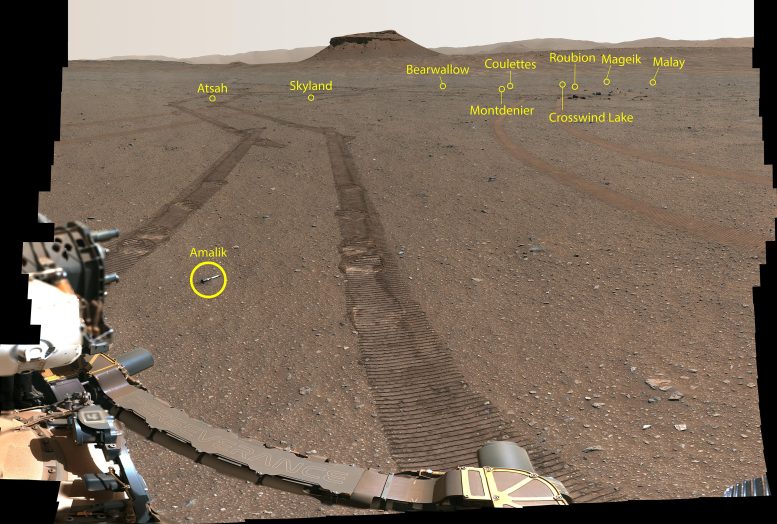
Perseverance’s Portrait of the Sample Depot: An annotated version of the portrait captured by NASA’s Perseverance shows the location of the 10 sample tubes in the depot. The “Amalik” sample closest to the rover was about 10 feet (3 meters) away; the “Mageik” and “Malay” samples farthest away were approximately 197 feet (60 meters) from the rover. Credit: NASA/JPL-Caltech/ASU/MSSS
Eight of those tubes are filled with rock and regolith (broken rock and dust), while one is an atmospheric sample and one is a “witness” tube. The rover photographed the depot using the Mastcam-Z camera on the top of its mast, or “head,” on January 31, 2023. The color has been adjusted to show the Martian surface approximately as it would look to the human eye.
The depot represents a backup collection of samples that could be recovered in the future by the Mars Sample Return campaign, a joint effort between NASA and ESA (European Space Agency) that aims to bring Mars samples to Earth for closer study. The rover began building the depot on December 21, 2022, precisely spacing the tubes in case they need to be retrieved at a future date.
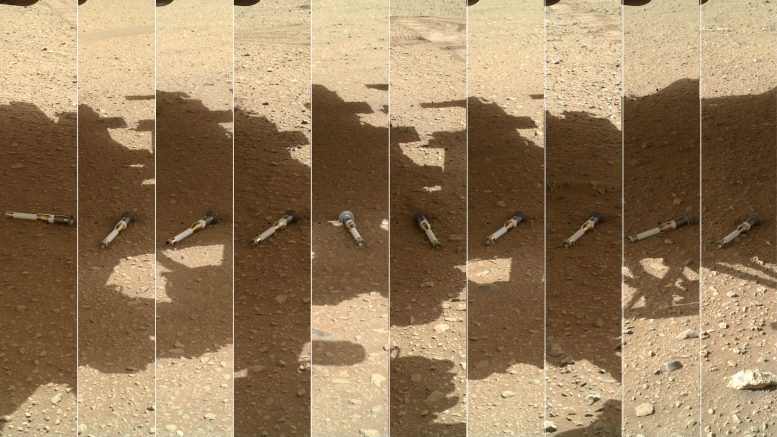
WATSON’s Photomontage of Mars Sample Depot: This photomontage shows each of the sample tubes shortly after they were deposited onto the surface by NASA’s Perseverance Mars rover, as viewed by the WATSON (Wide Angle Topographic Sensor for Operations and eNgineering) camera on the end of the rover’s 7-foot-long (2-meter-long) robotic arm. Credit: NASA/JPL-Caltech/MSSS
The primary tubes reside in the belly of Perseverance, which would pass them, along with future samples taken during the mission to a Sample Retrieval Lander as part of the campaign. If anything were to happen to the rover to prevent it from delivering tubes directly to the lander, samples could be retrieved from the depot instead. (Learn more about all 18 samples taken so far.)
Perseverance built the depot at “Three Forks,” a location within Jezero Crater. Billions of years ago, a river flowed into the crater, carrying sediment that formed a steep, fan-shaped delta that the rover will drive up in the months ahead.
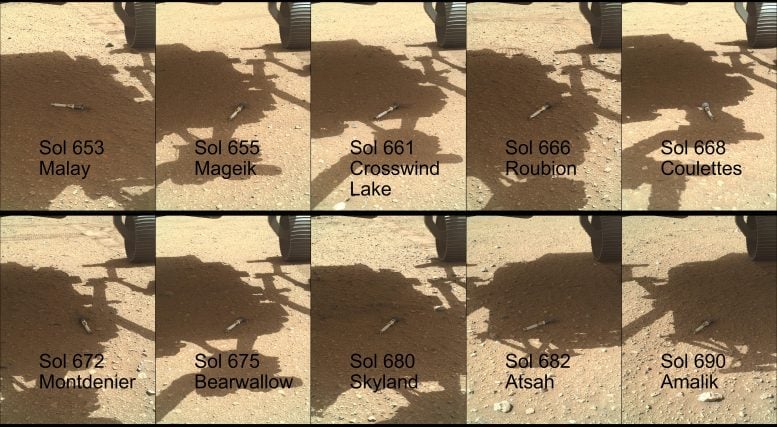
WATSON’s Photomontage of Mars Sample Depot: This photomontage shows each of the sample tubes shortly after they were deposited onto the surface by NASA’s Perseverance Mars rover, as viewed by the WATSON (Wide Angle Topographic Sensor for Operations and eNgineering) camera on the end of the rover’s 7-foot-long (2-meter-long) robotic arm. The images are annotated with the name of each sample and the Martian day, or sol, that it was deposited. Credit: NASA/JPL-Caltech/MSSS
While the Martian surface is now cold, dry, and generally inhospitable to life, ancient Mars was likely similar to Earth – and could have supported microbial life, if any ever formed on the Red Planet. The samples Perseverance is collecting could help scientists determine whether life ever left its mark in a place like Jezero Crater.
More About the Mars 2020 Perseverance Rover Mission
Perseverance’s mission on Mars has a key objective of astrobiology, which involves searching for indications of microbial life that existed in the past. The rover’s primary duties include characterizing the planet’s geological features and past climate, laying the groundwork for future human exploration of the Red Planet, and executing the inaugural task of retrieving and storing Martian rock and regolith, or loose rock and dust.
Following this, NASA will partner with the European Space Agency (ESA) to dispatch spacecraft to Mars to retrieve these sealed samples from the surface and transport them back to Earth for extensive analysis.
The Mars 2020 Perseverance mission is a component of NASA’s comprehensive plan for Moon to Mars exploration, which includes the Artemis missions to the Moon that will serve as preparation for eventual human exploration of Mars.
The Jet Propulsion Laboratory (JPL), which is managed by Caltech in Pasadena, California on behalf of NASA, is responsible for the development and operation of the Perseverance rover. Arizona State University is in charge of operating the Mastcam-Z instrument and works alongside Malin Space Science Systems in San Diego on camera design, construction, testing, and operation. Furthermore, in collaboration with the Neils Bohr Institute of the University of Copenhagen, they design, construct, and test the calibration targets.




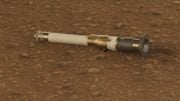



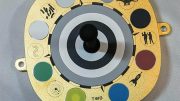
Be the first to comment on "NASA’s Perseverance Mars Rover Shows Off Collection of Martian Samples in Stunning Panorama"